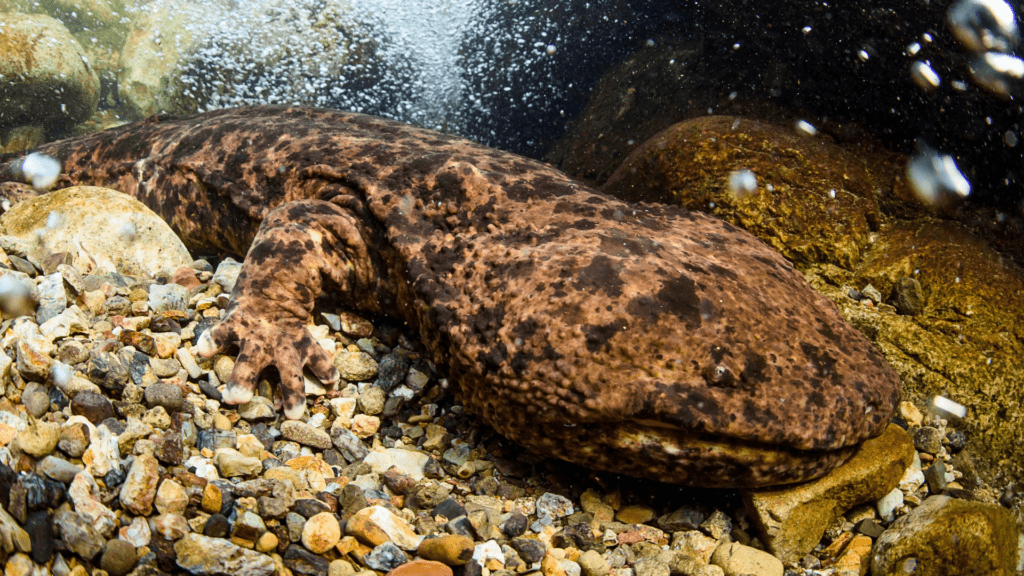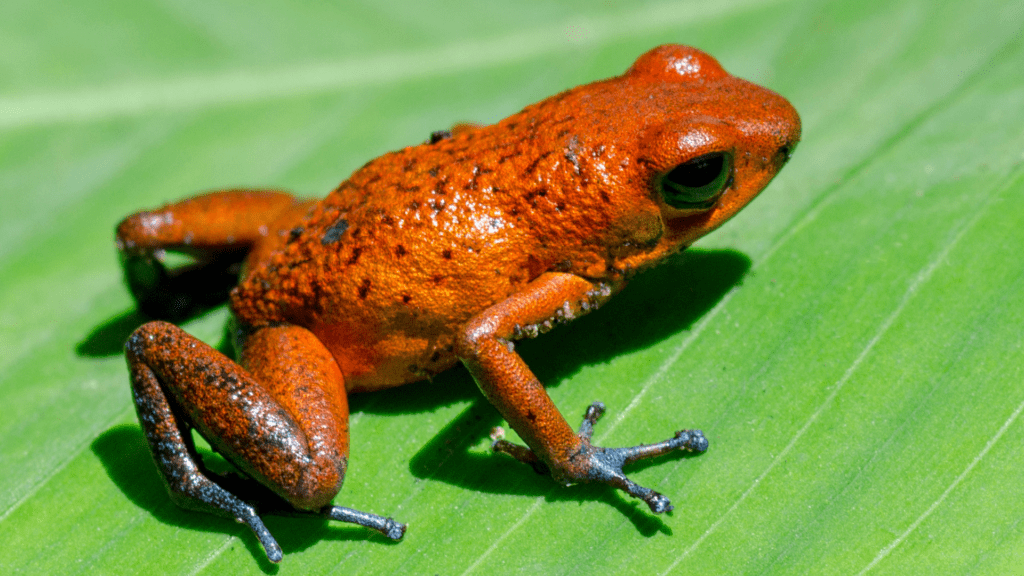Wood Frog (Rana sylvatica) is an intriguing species admired by biologists and scientists for its incredible freeze tolerance and fascinating behavior. Known for its unique ability to survive freezing temperatures, the Wood Frog is also recognized for its long-range movements and distinct preying habits.
Scientific Classification
- Kingdom: Animalia
- Phylum: Chordata
- Class: Amphibia
- Order: Anura
- Family: Ranidae
- Genus: Rana
- Scientific Name: Rana sylvatica
Wood Frog is designated as the state amphibian of New York and can be found throughout North America in diverse regions.
Physical Characteristics
Wood Frog’s appearance is both unique and adaptable, with features that help it thrive in various environments.
Coloration and Size
Wood Frogs are generally tan, pink, or dark brown. A distinctive dark eye mask runs across their face, ending abruptly behind the eardrum. They often have a light line down their backs, and their bellies are white with dark mottling. These tiny creatures grow to a length of approximately 3.5 to 8.3 cm.
Toes and Thumbs
Unlike some other frogs, the Wood Frog does not have fully webbed toes. Male Wood Frogs also have swollen thumbs, which aid in mating.
Adaptation to Cold: Hibernation and Freeze Tolerance
Wood Frog is remarkable for its ability to survive extremely cold temperatures. During the winter, these frogs hibernate in soil or leaf litter, where they enter a state of dormancy. Their bodies accumulate urea in the tissues and liver, which, combined with the conversion of glycogen into glucose, prevents ice from forming inside their cells. This ability allows them to survive even when 65% of their body water freezes.
Life Span and Diet
Life Span
The average life expectancy of a Wood Frog is 2-3 years, though many do not live this long due to predation or environmental factors.
Diet
Wood Frogs primarily feed on bugs and algae. Their hunting technique is similar to other members of the Ranidae family. They thrust forward, open their mouths, and extend their tongues rapidly to catch prey.
Habitat and Environmental Adaptation
Wood Frogs are highly adaptable and can thrive in a wide range of environments. They are found across North America, typically in forests, woodlands, and wetland areas, such as ponds, marshes, and streams. These amphibians are often associated with areas that experience seasonal changes, which play a crucial role in their life cycle.
Habitat: it”s prefer wooded or forested regions where they can find both aquatic environments for breeding and terrestrial habitats for shelter. They are commonly found in temporary or seasonal pools, which provide the necessary conditions for their eggs to hatch and larvae to develop. These pools often dry up later in the year, which is part of the reason why Wood Frogs are highly resilient and capable of completing their life cycle in such environments.
Environmental Adaptation: One of the most remarkable adaptations of this species is their ability to survive in freezing temperatures. During the winter months, they enter a state of hibernation, and some species can even survive being frozen for extended periods. This is made possible through a unique physiological process in which their body produces cryoprotectants, substances that protect their cells from damage caused by freezing. When temperatures rise again in the spring, the frogs “thaw” and resume their normal activities, emerging from their hibernation to begin the breeding season.
Wood Frogs are also known for their ability to adapt to a variety of ecological conditions. They can live in areas with fluctuating water levels, and their life cycle is timed to take advantage of short, wet periods in the spring and summer. This ensures that their tadpoles have enough time to develop before the water sources dry up.
These adaptations make Wood Frogs a remarkable example of resilience in the face of changing environments, demonstrating their ability to thrive in diverse and often harsh conditions.

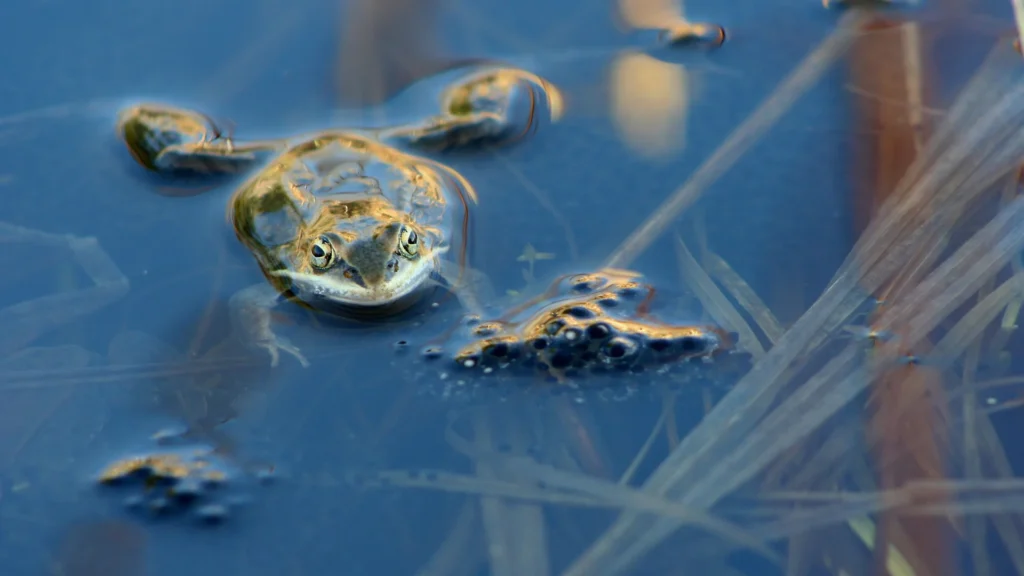
Geographical Range
Wood Frogs are widely distributed across North America, from northern Georgia and northeastern Canada to Alaska and Southern British Columbia. They can also be found in places like the Medicine Bow National Forest.
Reproduction and Life Cycle
Eggs: Female Wood Frogs can lay up to 3,000 eggs at a time. These eggs are typically deposited near submerged vegetation. The egg masses are often found in shallow pools or temporary ponds, where they can develop in the warm, nutrient-rich waters.
Tadpoles: Once the eggs hatch, the larvae, or tadpoles, begin their aquatic life. These tadpoles feed on algae and organic matter in the water, growing rapidly during the early stages of development.
Metamorphosis: The tadpoles undergo metamorphosis in about 2 months, transforming into adult frogs. This process involves significant physical changes, including the development of legs and the absorption of the tail. As the tadpoles transform into frogs, they begin to venture onto land to continue their life cycle.
Mating Behavior: Mating typically occurs in early spring, during the breeding season, when the male frogs call out to attract females. These vocalizations help males establish territory and attract potential mates. The call is often a distinctive, quacking sound, which gives the species its common name, the “Wood Frog.”
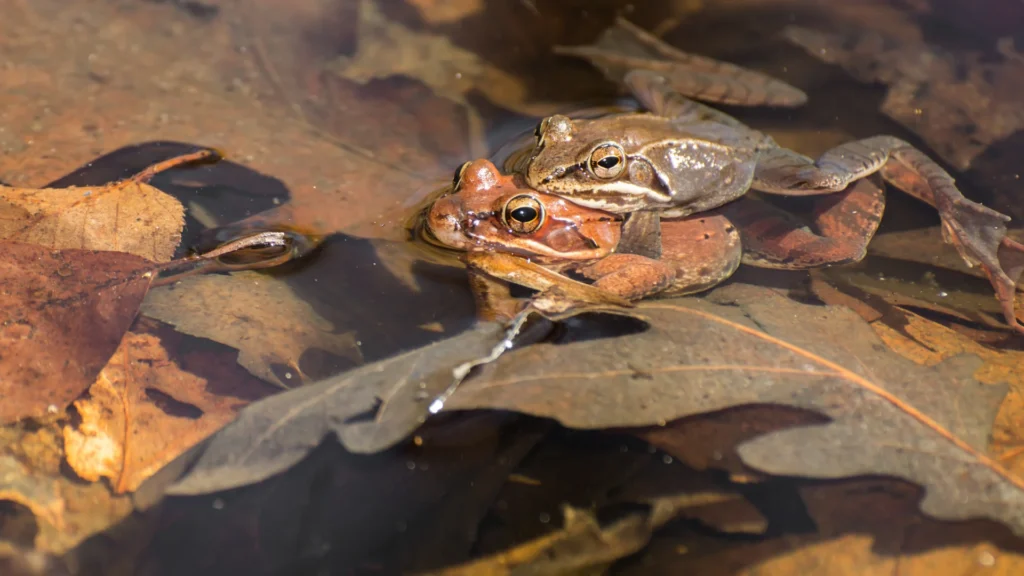
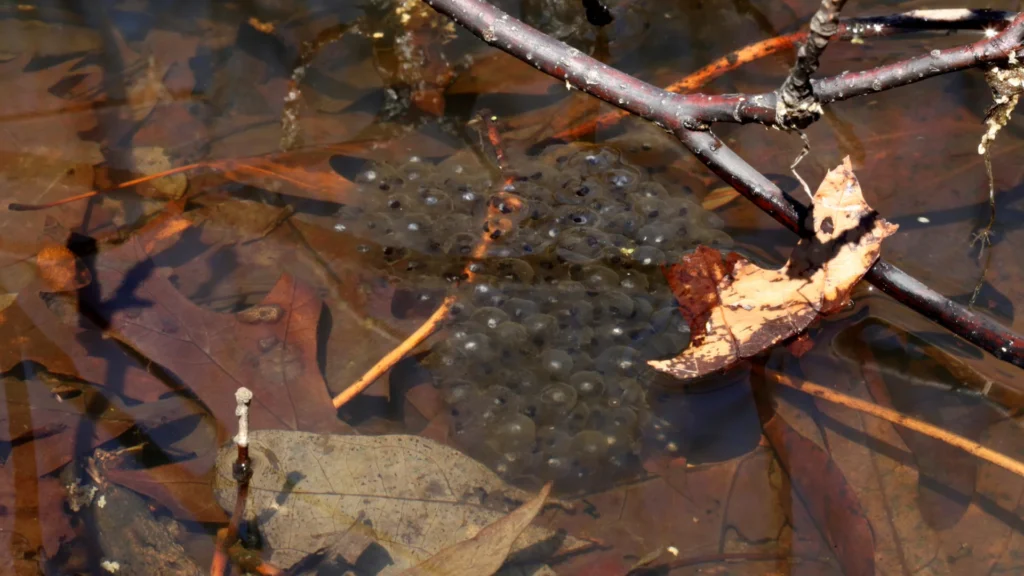
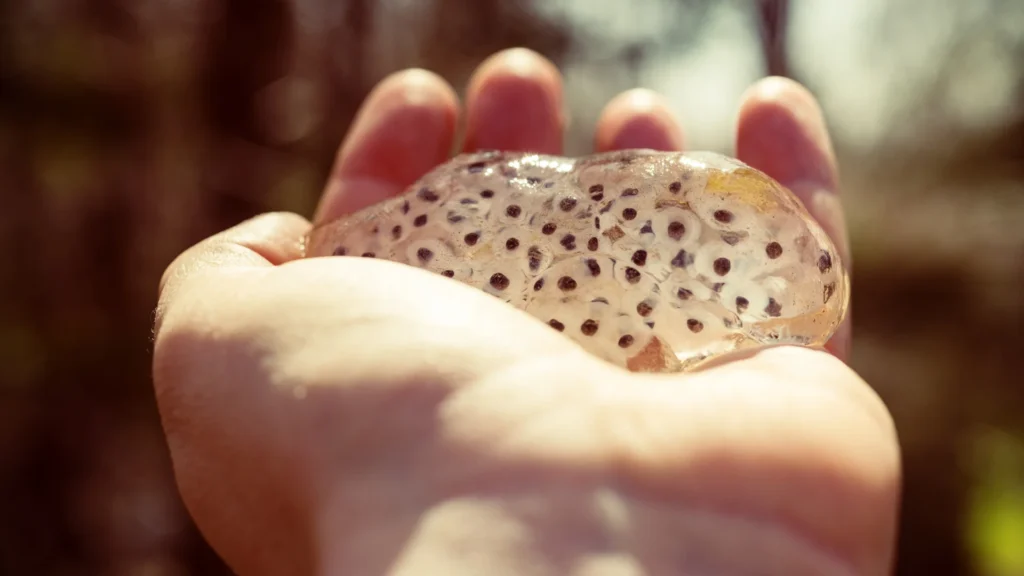
Behavior and Hibernation
Wood Frogs are known for their hibernation habits. During the winter, they seek shelter under wood logs, leaf litter, or stumps. Their bodies freeze, and upon the arrival of spring, they thaw out, resuming their active behaviors.
Unique Freeze Tolerance
The ability to freeze and thaw is one of the most extraordinary aspects of This amphibian behavior. During the winter, their hearts stop beating, and their bodies crystallize into ice. However, the production of antifreeze compounds prevents vital organs from freezing. This remarkable survival mechanism makes them one of the only frogs to survive north of the Arctic Circle.
Conservation Status
Wood Frog, despite its broad distribution, is not currently considered an endangered species. It is found across various regions, from woodlands to wetlands, thriving in areas that provide suitable conditions for breeding and shelter. Thanks to its ability to adapt to a variety of environmental challenges, the species has managed to maintain stable populations in many parts of North America.
One of the primary reasons for its stable conservation status is its remarkable adaptability. This amphibian is capable of surviving in a wide range of habitats, including temporary pools that dry up after the breeding season, and it can even endure freezing temperatures during hibernation. This resilience ensures that even in areas with fluctuating climate conditions, the species can still reproduce successfully and maintain its numbers.
Moreover,it’s life cycle is well-timed with the seasonal changes in its environment, allowing it to take advantage of the brief wet periods of the spring and summer. This strategic timing helps avoid competition with other amphibians and ensures that their offspring have enough time to develop before water sources begin to recede.
Though not currently at risk, conservation efforts are still important to monitor any potential threats to their populations. Habitat destruction, pollution, and climate change can still impact the delicate ecosystems that Wood Frogs rely on. Ensuring the preservation of these habitats is crucial for the long-term health of the species.
Interesting Facts
- they are the only frogs found north of the Arctic Circle.
- They freeze in winter, with their bodies turning into ice, yet they can thaw out when the temperature rises.
- Male Wood Frogs can be identified by their swollen thumbs.
- Despite freezing, even their fertilized eggs remain unaffected.
- This amphibian can jump farther than most other frogs and are known for their ability to ambush or sneak up on prey.
Conclusion
Wood Frog is a resilient and fascinating species, equipped with unique adaptations that allow it to thrive in harsh climates. Its ability to survive freezing conditions and its diverse diet make it a model of survival in the animal kingdom. Whether it’s the distinctive dark eye mask, its hibernation habits, or the freeze tolerance, This amphibian continues to intrigue and inspire researchers and nature enthusiasts alike.
faq’s
1. What is the scientific name of the Wood Frog, and to which family does it belong?
The scientific name of it is Rana sylvatica. It belongs to the family Ranidae, which includes other true frogs.
2. What unique physiological adaptation allows the Wood Frog to survive freezing temperatures?
it has developed freeze tolerance, where its body can withstand freezing by accumulating urea in its tissues and liver. The conversion of glycogen into glucose helps prevent ice formation inside its cells, allowing it to survive even when 65% of its body water freezes.
3. How does the Wood Frog’s hibernation process differ from that of other frogs?
Unlike most frogs, which hibernate by burrowing underground, the Wood Frog hibernates close to the surface, often in leaf litter or soil. During hibernation, it can freeze completely, and its metabolic processes are suspended until it thaws in the spring.
4. What is the typical size range of an adult Wood Frog?
The adult Wood Frog typically grows to a length of 3.5 to 8.3 cm. Its small size is a characteristic feature that helps it survive in various environments.
5. What are the primary components of the Wood Frog’s diet?
it is a carnivorous amphibian that feeds primarily on insects, bugs, and algae. It hunts by thrusting its body forward, opening its mouth, and rapidly extending its tongue to capture prey.
6. Describe the geographical range of the Wood Frog and its distribution across North America.
The woodland frog is widely distributed across North America, ranging from northern Georgia and northeastern Canada to Alaska and Southern British Columbia. It is also found in regions like the Medicine Bow National Forest.
7. How does the reproductive cycle of the Wood Frog work?
The female Wood Frog can lay up to 3,000 eggs at a time, typically near submerged vegetation. The eggs hatch within 3 weeks, and the tadpoles undergo metamorphosis in about 2 months, transitioning into adult frogs.
8. What role does the “dark eye mask” play in the Wood Frog’s appearance?
The dark eye mask is a prominent feature of the Wood Frog, which extends from behind the eyes and ends behind the eardrum. This marking helps with camouflage in the forested habitats where the Wood Frog lives.
9. What is the lifespan of the Wood Frog, and what factors influence it?
The typical lifespan of a Wood Frog is 2-3 years. However, many individuals do not reach this age due to predation, environmental challenges, or freezing conditions during hibernation.
10. What makes the Wood Frog’s freeze tolerance a subject of scientific interest?
The Wood Frog’s ability to survive freezing is of great scientific interest due to its unique physiological processes, including the production of antifreeze proteins that protect its cells from ice formation. This makes the Wood Frog an important model for studying freeze tolerance in animals and could have implications for human cryobiology and preservation.
